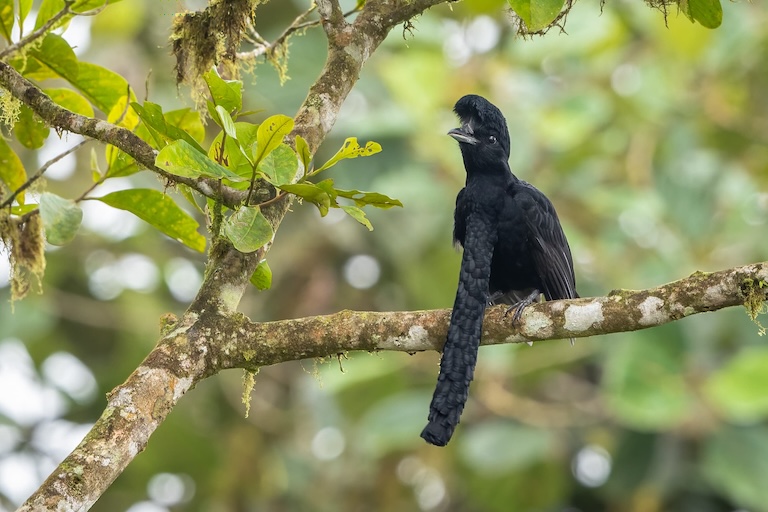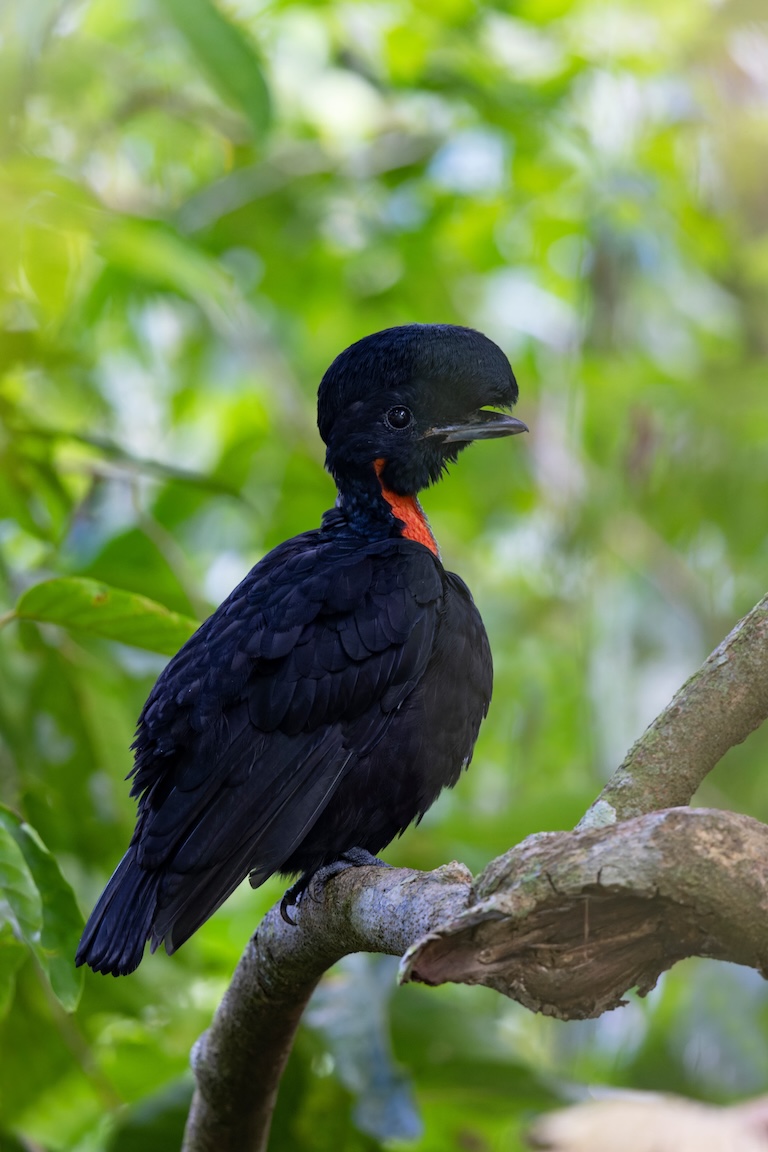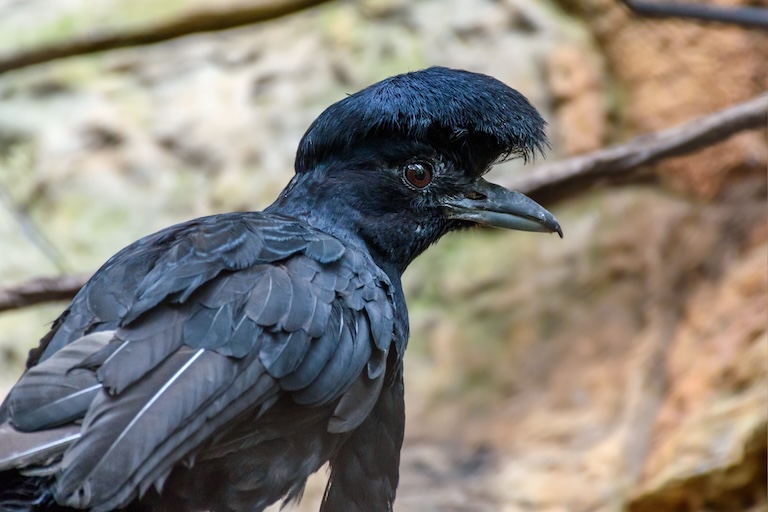Umbrellabird Profile
Central and South America are home to around a third of all bird species, among many other animals, and this diversity stems from its vast and enduring forest ecosystems, which are the most nurturing of all biomes on land.
Rainforests are where we, too, originated, before we climbed down from the trees and started stealing mammoth meat off of leopards, and as our ancestral home, and the home of many contemporary human communities, that should create a sense of responsibility. But sadly, forest destruction is wiping out species left, right and centre, and many, like the outstanding Umbrellabirds, have nowhere else to go.

Umbrellabird Facts Overview
| Habitat: | Rainforests, from 200 metres to 2,000 metres |
| Location: | Central and South America |
| Lifespan: | Not listed |
| Size: | Up to 55 cm (22 in) |
| Weight: | Up to 570 g (1.26 lb), |
| Colour: | Black, one species has a red throat. |
| Diet: | Fruits, large insects, and occasionally small vertebrates |
| Predators: | Raptors |
| Top Speed: | Slow, lumbering flight |
| No. of Species: | 3 |
| Conservation Status: | Endangered, vulnerable and Least Concern |
Umbrellabirds are named after their inflatable heads, likely by someone who’s never seen an umbrella. In their local language, their name reflects their incredible calls, which echo through the forest as exquisite “Booms”, amplified by these inflatable organs.
They’re some of the largest songbirds on Earth, and all three species are incredible to look at. These are fruit eaters, primarily, and significant seed dispersers as such. Sadly, two of the three are in serious trouble as a result of habitat destruction.
Interesting Umbrellabird Facts
1. They’re Cotingas
Umbrellabirds are in the Cotingidae family of passerine birds, and are, as such, primarily fruit eaters. This family is as diverse as you’d expect from South America, and contains around 66 known species, all of which are found in South and Central America.
Umbrellabirds make up three of these species, in the genus Cephalopterus, and are distributed across both regions.
Cotingas vary in many ways, including brood care, shape, colour, social structure and size. At one end of the size spectrum, you have the 12cm fiery throated fruiteater, and at the other, you have the Umbrellabirds.

2. They’re large
In terms of biodiversity, South America is perhaps known for its songbirds more than anything else. Songbirds, or Passerines, are the largest order of birds in the world, with over 140 families, and upwards of 7,000 likely species all over the world. This order makes up 60% of all birds in three suborders. One of them, the Suboscines, originated in South America around 50 million years ago, and now contains over 1000 species of birds, most of which are still there.
Of this group, the largest is the Amazonian umbrellabird, Cephalopterus ornatus. Likely named after the forest, and not the fact that it’s enormous and sexy, but both are applicable.
This bird is 55cm long, just 15cm shorter than the largest passerine in the world, the thick-billed Raven. So, this is a big bird, and like the raven, it’s very black, with a robust beak and intelligent eyes. Unlike the raven, though, they can boom!
3. Boom!
All three species have inflatable neck appendages called wattles, which are for both visual and acoustic displays.
The local name for these birds is ueramimbé, meaning “piper bird”, and this refers to the acoustic role of the inflatable skin, which blows up and functions as a horn to amplify its call.
And this call is seriously cool. It’s one of the deepest frequencies produced by any songbird, at around 300Hz. For such a small animal, this is an impressive range.
As the name suggests, the long-wattled umbrellabird has the largest organ and has a meme-worthy struggle with flight on account of how large its dangly bits are.
So, these birds sacrifice quite a bit of function for form when it comes to aviation, but this doesn’t stop them from migrating.
4. They’re mountaineers
Umbrellabirds are migratory, but not in the usual sense. Their migrations are vertical and more akin to those found in various deep-sea creatures. During breeding seasons, they ascend the mountains, away from the majority of threats, where they lay their eggs – or, in the case of these birds, a single egg – and incubate it in the cloud forests at around 2,000 metres altitude.
Once breeding has finished, they spend the rest of the year between 200 and 500 metres.

5. They’re solitary
The Cotingas, as we mentioned, vary in social structure quite a bit. Around half share the responsibilities of looking after the young, and the other half leave it up to the female. The Umbrellabirds fall into this latter category, which might sound a bit like an unfair strategy, but ties into the amount of effort males put into their share of the mating responsibilities.
Females are entirely solitary and will visit display arenas very rarely, so the males, in large groups, gather at these “lekking” sites to show off and win her affections.
Competition is high, and displays are tiresome and resource-intensive, and since the female lays only a single egg, most males won’t breed every year.
6. This stimulates the forest
All this lekking produces a lot of waste. Like a trash-covered field after a festival, abandoned lekking sites are covered in umbrellabird poo, and in these mountains of butt porridge, there are countless seeds from the various fruits the males were sustaining themselves on.
These seeds, therefore, are distributed alongside their own little dollop of guano for fertiliser and grow into the next generation of fruit trees. 1
7. They’re in trouble
The Amazonian umbrellabird is listed as of Least Concern by the IUCN, but the same can’t be said of the other two species.
The long-wattled umbrellabird is vulnerable, and the bare-necked umbrellabird is endangered.
Banana and pineapple plantations in Costa Rica have decimated lowland forest habitat for the latter species, and the long-wattled umbrellabird suffers much of this, as well as the additional threat of trapping for the pet trade.
Considering not only their beauty but also how unique and significant these birds are to their ecosystems, their protection, alongside the rest of the members of the rainforest communities, is of utmost importance. 2 3
Umbrellabird Fact-File Summary
Scientific Classification
| Kingdom: | Animalia |
| Phylum: | Chordata |
| Class: | Aves |
| Order: | Passeriformes |
| Family: | Cotingidae |
| Genus: | Cephalopterus |
| Species Name: | 3 species |
Fact Sources & References
- Karubian et. al (2012), “Mating Behavior Drives Seed Dispersal by the Long-wattled Umbrellabird Cephalopterus penduliger”, Wiley Online Library.
- (2022), “Long-wattled Umbrellabird”, IUCN Red List.
- (2020), “Bare-necked Umbrellabird”, IUCN Red List.
